#Holy Monastery of the Great Meteoron
Text
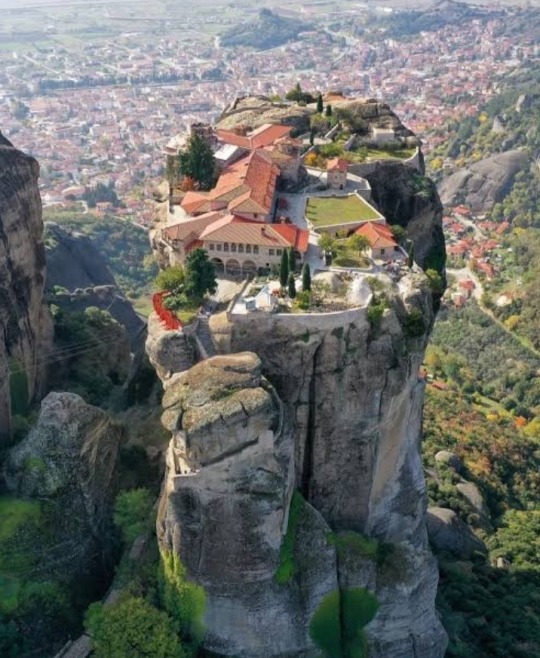

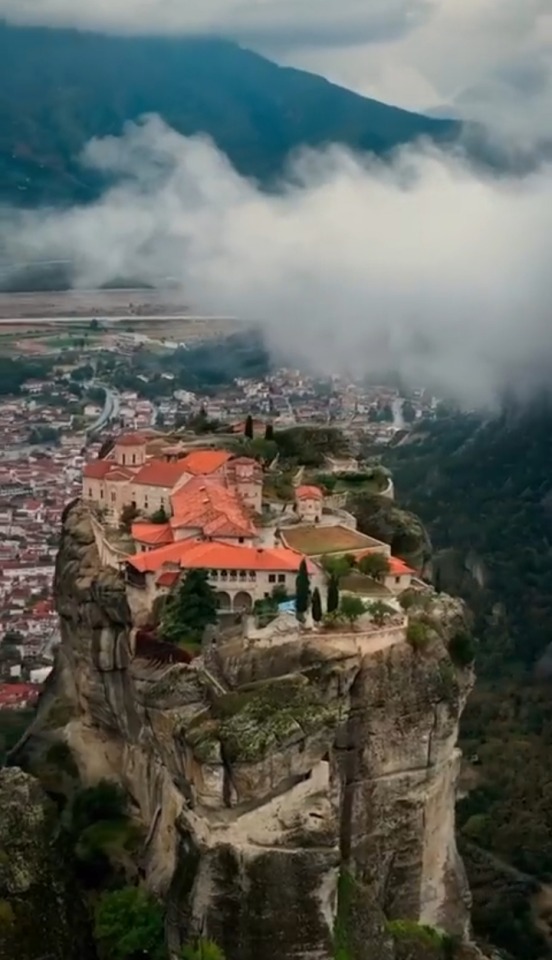
Meteora is an exquisite complex that consists of huge dark stone pillars rising outside Trikala, near the mountains of Pindos.
Monasteries that sit on top of these rocks make up the second most important monastic community in Greece, after Mount Athos in Halkidiki.
Out of the thirty monasteries that were founded throughout the centuries, only six of them are active today.
History of Meteora goes many millenniums back. In Greek, the name Meteora aptly translates to “suspended in air.”
Theories upon the creation of this natural phenomenon are associated with the geological movements that have occurred several geological periods ago.
Scientists believe that these pillars were formatted about 60 million years ago, during the Tertiary Period.
That time, the area was covered by sea but a series of earth movements caused the seabed to withdraw.
The mountains left were continuously hit by strong winds and waves, which, in combination with extreme weather conditions, affected their shape.
This is why the pillars are composed of sandstone and conglomerate.
In Byzantine times, monks had the inspiration to construct monasteries on top of these rocks so that they would be closer to god.
The foundation of Meteora monasteries began around the 11th century CE.
In the 12th century CE, the first ascetic state was officially formed and established a church to the Mother of God as their worshiping center.
Activities on this church were not only related to worshiping God, but hermits used these occasions to discuss their problems and exchange ideas relating to their ascetic life there.
In the 14th century CE, Saint Athanasios established the Holy Monastery of the Transfiguration of Jesus and named this huge rock Meteoro, which means ''hanged from nowhere.''
This monastery is also known as the Holy Monastery of the Great Meteoron, the largest of all monasteries.
For many centuries, the monks used scaffolds for climbing the rocks and getting supplies.
As years passed, this method was followed by the use of nets with hooks and rope ladders. Sometimes a basket was used, which was pulled up by the monks.
Wooden ladders of 40 meters long were also one of the essential tools for accessing the monasteries.
Between the 15th-17th century CE, Meteora was at its prime with the arrival of many monks from other monasteries or people who wanted to lead an ascetic life in this divine environment.
However, the prosperity of Meteora during that time started to fade away after the 17th century CE, mainly due to the raids of thieves and conquerors.
These caused many monasteries to be abandoned or destructed.
Today, only 6 monasteries operate with a handful of monks each. The only nunnery (female monastery) is the Monastery of Agios Stefanos.
Meteora was added to the UNESCO World Heritage List in 1988 because of the outstanding architecture and beauty of the complex, in addition to its religious and artistic significance.
📷: credit to the owner (photo 1) / Christos Kapoulas (photos 2 and 3)
© Greeka
#Meteora#Trikala#Pindos#Greece#monasteries#pillars#Tertiary Period#church#Saint Athanasios#Holy Monastery of the Transfiguration of Jesus#Holy Monastery of the Great Meteoron#monks#nunnery#Monastery of Agios Stefanos#rock formation#UNESCO World Heritage List#architecture#Thessaly#nuns
5 notes
·
View notes
Video
View on the Holy Monasteries of Great Meteoron and Varlaam por domingo leiva
Por Flickr:
dleiva.com/
#Meteora#Greece#Awe#Landscape - Scenery#Majestic#Ancient#Greek Culture#History#Travel Destinations#Architectural Column#Architecture#Famous Place#Kalabaka#Monastery#Sandstone#Antique#Beauty#Fame#Geographical Locations#Geology#High Up#Horizontal#International Landmark#Nature#Old-fashioned#Outdoors#Panoramic#Photography#Plain#Rock - Object
1 note
·
View note
Photo

Meteora High above the Meteora landscape in the central region of Greece, 60 monks and nuns live in fabled monasteries perched on the edge of sandstone peaks. In centuries past, their place of worship brought them solitude and protection from unwanted trespassers. Only a few hours from Athens at the fringe of the Plain of Thessaly, the town of Kalambaka plays host to Meteora's spectacular mountaintop attractions. Windswept monoliths rise abruptly from the earth, with vertical cliffs forming a dramatic backdrop against the flat fields around them. During the 14th century, the great monk Athanasios Koinovitis brought a group of devout followers from Mount Athos to Meteora, in search of a group of ascetic hermits that had developed a religious stronghold in the region. He was mesmerised by the hermits' free-climbing skills that had allowed them to live in the caves and fissures high above the ground, and saw an opportunity to create a convent where his flock could meditate and worship in peace. Employing the hermits as climbing mentors, the new visitors conquered the surrounding mountains and set about creating their own holy haven. It was then, from 1356 to 1372, that the first Great Meteoron Monastery was born. Meteora means "suspended in the air," and the way the religious house clung dangerously to the formidable peak quickly gave its name to the entire district. Years later when the Turks advanced on northern Greece, more monks escaped persecution by climbing the mountains to safety. Over time 24 monasteries were built with the steep pillars providing protection from the warriors below. A network of ropes, pulleys, baskets and ladders were used to lift worshipers and supplies into the monasteries. These were raised in times of danger to deny access to anyone who posed a threat. The method worked and the Orthodox monks easily survived centuries of war and battles. (at Meteora) https://www.instagram.com/p/CW-pWuGoY8-/?utm_medium=tumblr
0 notes
Text
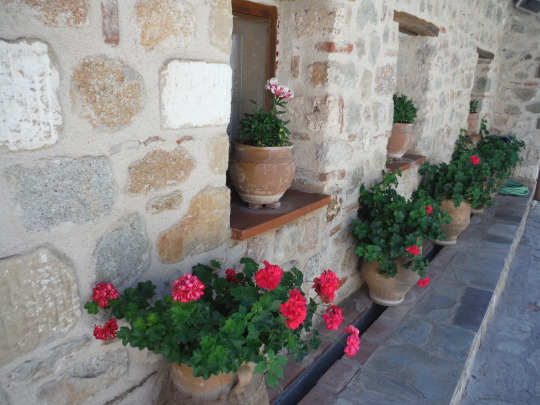

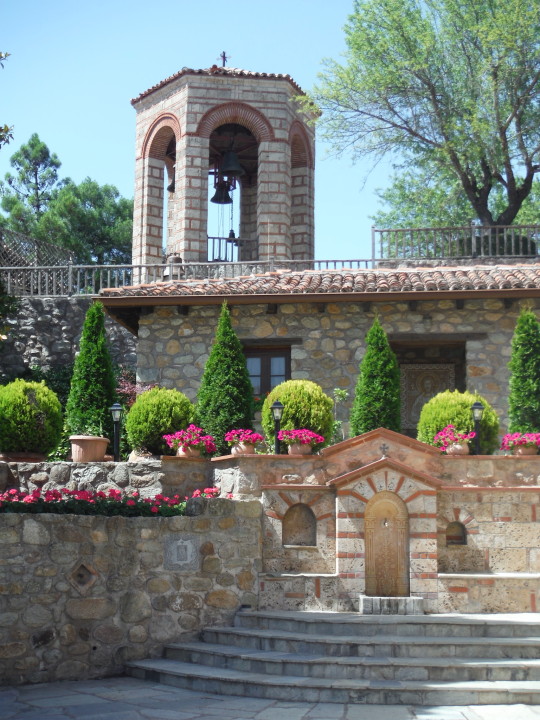
16/06/2016: Terrace exterior of the Great Meteoron Holy Monastery of the Transfiguration of the Saviour
#the mountains of meteora#greece#what i did on my holidays#take my mum to greece#2016#view from a monastery#monastery gardens#great meteoron
1 note
·
View note
Text
Athens to Meteora Private Tour Athens Private Driver
Athens Private Driver provides a wide range of transfer services, driver-guided tours for individuals, families and groups, customized programs, and unique accommodation in Hotel, B&B, Country Houses and Agriturismo.
We are in the business of creating great travel memories to every destination through the finest fleet of vehicles and the most professional drivers and guides.
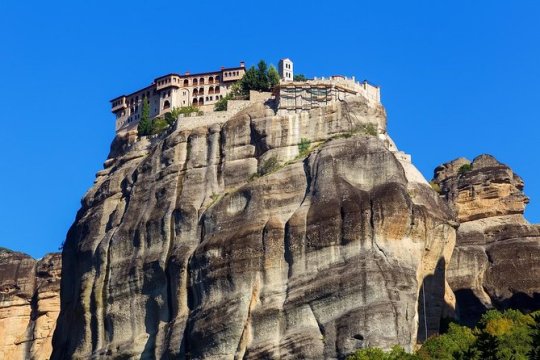
High above the Meteora landscape in the central region of Greece, 60 monks and nuns live in fabled monasteries perched on the edge of sandstone peaks. In centuries past, their place of worship brought them solitude and protection from unwanted trespassers. Today, the Orthodox monasteries are one of the most popular destinations in all of Greece.
Meteora means "suspended in the air," and the way the religious house clung dangerously to the formidable peak quickly gave its name to the entire district. Years later when the Turks advanced on northern Greece, more monks escaped persecution by climbing the mountains to safety. Over time 24 monasteries were built, with the steep pillars providing protection from the warriors below. A network of ropes, pulleys, baskets and ladders were used to lift worshipers and supplies into the monasteries, and these were raised in times of danger to deny access to anyone who posed a threat.The method worked, and the Orthodox monks easily survived centuries of war and battles. Today, six of these monasteries remain, segregated between male monks and female nuns, and visitors are welcomed with typical Greek hospitality.
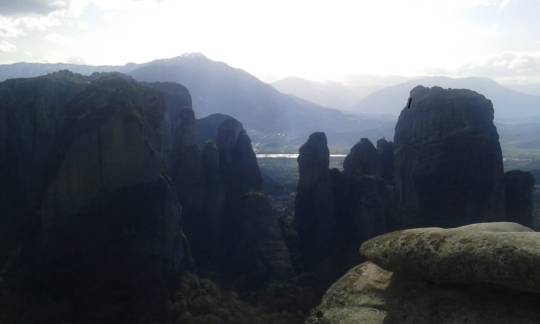
Private Driver Athens to Meteora
Athens Private tour to Meteora starts early morning from your accommodation/hotel with one of our luxury , air-conditioned coaches. The route takes places on the central highway leading to the north side of mainland Greece. Our Private Tour continues with one spectacular view after another of the lush Greek countryside as we ride through the towns of Lamia and Domokos and Greece’s smart city of Trikala.
As we get closer to the town of Kalampaka who plays host to Meteora's spectacular mountaintop attractions., you will be instantly enchanted by the splendour of these one-of-a-kind complex UNESCO-listed sanctuaries, each built on a giant rock pillar between the 14th and 16th centuries.
The monasteries of Meteora you can visit are six: The Monastery of Great Meteoron, the Monastery of Varlaam, the Monastery of Rousanou, the Monastery of St. Nicholas Anapausas, of St. Stephen and the monastery of Holy Trinity, which is the hardest to reach. The intriguing history of the monasteries and the incredible landscape make this a truly worth doing tour! Absorb their interiors and views, and learn how and why they were constructed.
But beyond the monasteries and mountains, Meteora is far from being just a visual delight. This little-known terrain holds claim to some of Europe's most fascinating history, as well as a heap of exhilarating outdoor activities.Just 2.5 miles outside of Kalambaka is Theopetra Cave, a stunning archaeological site that holds evidence of continuous human inhabitation for over 130,000 years.
After the visit to the Monasteries, you will enjoy a fully flavored typical lunch at traditional Greek restaurant in the town of Kalambaka .
On the way back to Athens we will visit the “Thermopylae Museum” which is next to the monument of King Leonidas, in the historic Thermopylae, dedicated to the 480 BC battle that changed the course of Greek history, 300 Spartans against Persian Empire. The average visit time is 30-60 minutes and expect to see a museum which is completely interactive and equipped with 3D movies showrooms in which you can learn every single detail about the battle of the 300 .
At the last hours of the day you will reach Athens where our Athens private driver will drop u to your accommodation/hotel for well deserved rest .
This is a private tour that can be fully customized to your preferences and wills. We can cover all the active monasteries or include more hidden sites, avoid the crowds, include short hikes and discover some hidden hermit caves.
For more information Visit !!!! www.athens-privatedriver.com
0 notes
Photo
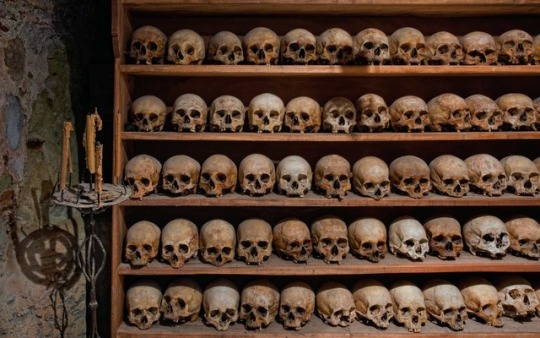
Skulls of old monks who lived in the monastery by Mike Reygman
The Holy Monastery of Great Meteoron, Meteora - Thessaly, Greece.
2 notes
·
View notes
Text
METEORA TRAVEL GUIDE: Itinerary, Budget, Things to Do 2018
The first hermits arrived in hopes of finding seclusion and spiritual peace. Centuries later, it is still easy to see why, of all places, it is here that they chose to dwell. Even amid the the busyness of tourists like us swarming around the monasteries and gawking at the surrounding landscape, Meteora remains as serene as slumber and as solemn as a prayer.
It’s not difficult at all to be captivated by Meteora. I had my first glimpse of it through a viral Facebook video that features the monasteries perched atop lofty rocky pillars. At that moment, I knew I had to set foot in it and see it for myself. There’s this old saying immortalized in memes: If you want something badly enough, the universe will make conspire to make it happen. I’m not one to rely on the wisdom from memes, but it turned out to be true in this case. I didn’t think I’d be able to visit Meteora this soon, but a series of fortunate events led me to this.
WHAT’S COVERED IN THIS GUIDE?
The name “meteora” means “high up in the air,” referring to the towering pillars that make up this rock formation, overlooking the plains of Thessaly in Greece. Since the first hermits took shelter in its caves, these sandstone columns have seen 24 Eastern Orthodox monasteries, making it one of the faith’s most important sites, second only to Mt. Athos. Because the monasteries were built on the summit of these rocks, they offer complete isolation. For most of its history, the only way to reach them were by long ladders, ropes, and nets.
Today, only six of these monasteries remain standing. Inscribed in the UNESCO World Heritage List, Meteora has been drawing tourists from all around the world for its historical, cultural, and geological significance as well as breathtaking scenery.
Here’s more info about Meteora.
Language: Greek. However, English is widely spoken.
Currency: Euro (EUR, €). €1 = 1.14 USD, SGD 1.6, PHP 61 (as of October 2018)
Modes of Payment: Cash is still the most common.
Electricity Info: 230 V, 50 Hz. Power sockets are Type F, which also accept Type C plugs.
April to June and November, when the weather is comfortable and the crowd isn’t that big.
July to October is high season, so rates in Greece in general are higher and the site is overrun by tourists. July and August are the driest and the hottest months.
December to March is winter. It’s not just the coldest, it’s also the wettest period. It doesn’t mean though that it rains every day. We visited in December, but it didn’t rain at all, not even a slight drizzle. Maybe we just got lucky. One important thing to note when traveling in winter is that there is no public bus service to Meteora from Kalambaka or Kastraki, which limits your transportation options significantly.
There are two towns lying at the foot of the Meteora cliffs: Kalambaka and Kastraki. To get to Meteora, you need to find your way to any of these.
Most independent travelers and backpackers prefer to stay in Kalambaka, which offers more lodging, dining, and tour options than Kastraki. In Greek, the official name of the town is Kalabaka, but it is also often called Kalambaka or Kalampaka. Don’t be confused. They all refer to the same town.
Here are some of the top-rated hotels in Kalambaka and Trikala, as scored by Traveloka and Tripadvisor users.
Famissi Hotel. Photos provided by Traveloka.
Search for more Meteora Hotels
The nearest airport is Nea Aghialos National Airport (aka Volos Central Greece Airport or Volos Nea Anchialos Airport), located in Central Greece, south of Thessaly.
But most tourists come from Athens. If you’re coming from Manila or Singapore, the most cost-efficient way to reach Athens is to fly with Scoot. Scoot fares to Athens start at PHP10,403 from Cebu, PHP10,704 from Clark, PHP11,198 from Kalibo and PHP10,754 from Manila. These can still go lower when there is a promo. Look:
Actual fares we found for March
All flights from the Philippines will have a layover in Singapore. You can take this opportunity to also tour SG while you’re at it. From SG, the travel time to Athens is 11 hours and 10 minutes. Scoot uses a new Boeing 787 Dreamliner, so you can expect the cabin to be spanking clean and well-maintained.
If you want to score ATHENS PROMO FARES, keep a lookout for Scoot’s monthly Take-off Tuesday promotions, which happens every first Tuesday-Thursday of every month, available on their official website!
Athens to Meteora by Train
It’s easy to reach Meteora by train. Kalambaka has its own train station and is connected to Larissa Train Station, which is the central railway station in Athens.
Take the Metro Red Line to Larissa Station. If you’re coming from Syntagma, it should be easy because Syntagma is also along Red Line, just four stations away. Fare: €1.40. If you’re coming from Athens Airport, you must first take the Blue Line to Syntagma Station and then transfer to Red Line to Larissa Station. Fare: €10.
At Larissa Station, board the train to Kalambaka. There is only one direct train per day, scheduled to leave Athens at 08:20am and arrive in Kalambaka at 01:18pm. Fare: €18.3 – €25.6. If that’s not an option for you, you may travel to Paleofarsalos first then switch to another train bound for Kalampaka. See the schedule below.
Alight at Kalambaka Station. This is the last stop.
From Kalambaka Station, take the bus to Meteora. From March to November, there’s a bus leaving Kalambaka at 9am, 12 noon, and 3pm. Fare: €1.80 one-way, €3.30 round trip. No public buses in winter. You can either take a cab instead or just hike, which is great and very scenic.
For the train timetable, visit: Athens-Kalambaka Train Schedule.
Athens to Meteora by Bus
There are no buses that go directly to Meteora or Kalambaka. Instead you will have to travel by bus to Trikala, the city closest to Meteora, and then transfer to another bus to Kalambaka.
Make your way to LIOSION 260 BUS STATION. This is the terminal where buses bound for Trikala are stationed. It’s at 260 LIOSION STREET.
– If you’re coming from other parts of the city center, you may take the metro. The nearest Metro Station is Kato Patisssia Station, which is 900 meters away. If you take the metro, make sure you have enough time allowance for walking. You can also just take a cab.
– If you’re coming from the airport, board City Bus X-93 and alight at Liosion Street Bus Station. Travel time: 55 minutes.
Take the bus bound for Trikala or Kalambaka. A bus leaves at 7:00am, 10:30am, 1:30pm, 3:30pm, 6pm, and 9pm daily. An extra 5pm trip is added every Friday and Sunday. Travel time: 5 hours.
In Trikala, transfer to another bus bound for Kalambaka. There’s one every hour. Travel time: 30 minutes to 1 hour. Total fare from Athens to Kalambaka is €31.50.
From Kalambaka Station, take the bus to Meteora. From March to November, there’s a bus leaving Kalambaka at 9am, 12 noon, and 3pm. Fare: €1.80 one-way, €3.30 round trip. No public buses in winter. You can either take a cab instead or just hike, which is great and very scenic.
For the train timetable, visit: Athens-Kalambaka Train Schedule.
Monasteries Tour
Six ancient monasteries remain standing to this day, and they’re all open to visitors. From Kalambaka, you can take the bus to the monasteries. The bus will stop in all six monasteries. Here’s the bus schedule for March 16 to November 30, 2018. This may change in the coming years so make sure to call your hotel to confirm the schedule. No bus service in winter.
Fare: €1.80 one-way, €3.30 round trip.
As you can see, there are only a few buses per day, so you won’t be able to see all the monasteries if you’re relying on the bus. What most tourists do is they take the bus going up and then they just explore the place on foot, then they take the last bus back to Kalambaka. Ideally, you should be able to visit 2-3 monasteries in a day. Although it is possible to see more than 3 in a day, the pace may be too fast or stressful.
Note that these monasteries are not open all week. Each has its own closing day. We indicated the operating days and hours for summer 2018 and winter 2019 below. However, please note that these change every year and every season so double check with official sources before your trip.
Great Meteoron Monastery
Summer hours: 9am-4pm (Closed: Tuesdays)
Winter hours: 9am-3pm (Closed: Tue-Wed)
Varlaam Monastery
Summer hours: 9am-4pm (Closed: Fridays)
Winter hours: 9am-3pm (Closed: Tue & Fri)
St. Stephen’s Monastery
Summer hours: 9am-1:30pm, 3:30pm-5:30pm
Winter hours: 9:30am-1pm, 3pm-5pm
Closed: Mondays
Roussanou Monastery
Summer hours: 9am-5pm
Winter hours: 9am-2pm
Closed: Wednesdays
Holy Trinity Monastery
Summer hours: 9am-5pm
Winter hours: 9am-4pm
Closed: Thursdays
St. Nikolaos Anapafsas Monastery
Summer hours: 8am-4pm
Winter hours: 9am-4pm
Closed: Fridays
All monasteries above charge a €3 entrance fee. Kids 12 and below can enter for free.
These monasteries offer not just stunning views. They also house important historical artifacts. For example, the Great Meteoron Monastery also showcases the role of the Orthodox Church in key events in Greek history including World War II. St. Nikolaos Anapafsas Monastery displays frescoes created by Theophanes in 1527.
The Great Meteoron Monastery and the Varlaam Monastery are the biggest and the two most popular. St. Stephen’s Monastery and Roussanou Monastery are the easiest to access.
You can do it on your own, but because of the site’s immense historical importance, joining a guided tour will make your trip not just enjoyable but also enlightening.
Half-day tours usually cost €25 to €35.
Great Saint Scrambling Tour
The Great Saint Rock is one of the most iconic in Meteora. If you’re up for an adventure and you’re in great shape, this is right up your alley. This is a guided tour that will lead you to the tallest rock in the area, around 400 meters above the ground. There will be some climbing, abseiling, traversing, and lots of hiking, so be prepared physically and mentally.
You MUST have a guide to be able to do this because it’s a bit dangerous. Tours start at €60.
Church of the Assumption of the Virgin Mary
Built in 7th century AD, this is one of the oldest churches in Greece. This Byzantine church is often overlooked by tourists even though it’s centuries older than the monasteries perched on the Meteora rocks. It has three aisles and features frescoes that can be traced back to as far as 14th century. Don’t miss the relics of an older Green temple can also be found inside.
If you’re staying in Kalambaka, you can easily make your way to this church.
Kastraki Village
Kastraki is one of the two villages at the foot of Meteora. Although Kalambaka harbors more hotels, restaurants, and tour agencies, Kastraki is quieter and more picturesque. Even if you’re staying in Kalambaka, Kastraki is worth a stop too. The village lies in between two colossal rocks, ensuring an unforgettable view from the base. The 19th-century houses along its streets are well-preserved, too!
Here’s a sample overnight Meteora itinerary. It assumes you’re arriving in Kalambaka before 2pm. We’ve indicated the entrance fees if you want to explore on your own as well as the usual tour rates if you want to join a guided tour.
DAY 1 – SUNSET TOUR
Arrival in Kalambaka
Hotel check-in
Meteora Sunset Tour: €30
St. Stephen Monastery. Entrance fee: €3
Dinner in Kalambaka
DAY 2 – MONASTERIES TOUR
Early check out
Sightseeing Tour: €30
Great Meteoron Monastery: €3
Varlaam Monastery: €3
Roussanou Monastery: €3
Lunch
Departure
If you’re exploring Meteora DIY-style and on foot, Meteora is going to be one of the cheapest trips you’ll have in Greece. But if you’re joining guided tours, prepare to shell out around €100 for the tour fees, entrance fees, and gratuities.
Is Meteora safe?
When it comes to crimes, yes, Kalambaka and Meteora are very safe generally. But as in other places, follow the rules and don’t leave your things unattended.
If you’re not physically fit, don’t join some of the hiking tours, especially the Great Saint Scramble. It is a physically demanding activity.
Because of the rugged terrain and lofty cliffs, there’s always danger especially when it rains, so be extra careful. Don’t go too close to the edge. Wear shoes that have a good grip.
Should I explore Meteora on my own or should I join a guided tour?
It is possible to explore Meteora on your own. As mentioned, from mid-March/April to November, there are buses that can take you to the monasteries. It is also accessible if you just hike. However, having a guide will make you have a better understanding of the history and significance of the place. If you’re hiking, the trail isn’t always well marked, so a guide can be a great help.
What to wear inside the monasteries? Is there a dress code?
Knees and shoulders must be covered. Men need to wear long pants (trousers) that cover the knees. Women must wear skirts that cover the knees. There are wraps and long pants that can be borrowed by the entrance.
Are there restaurants near the monasteries?
None. No restaurants or cafes. There are small stalls selling snacks nearby, but that’s about it. It’s best to bring your own water and easy-to-eat food.
What is tipping policy in Kalambaka?
Tipping is NOT mandatory or expected in Santorini. You can just round up the bill. If your bill is €23.5, they usually just pay €25. But if you’re very happy with the service, 10% of the bill should be fine.
Do I need a visa to visit Greece?
Greece is part of the Schengen Agreement. For short visits, a Schengen Visa is required for most nationalities except for nationals of 62 specified countries which include Singapore, Malaysia, and the United States.
If you’re a Philippine passport holder, you will need a Schengen visa. We have a separate post discussing the visa application process in detail.
Read: Schengen Visa via Greek Embassy
[embedded content]
Source: https://bloghyped.com/meteora-travel-guide-itinerary-budget-things-to-do-2018/
0 notes
Text
I could finally find a company that organized excursions from the Island of Corfu to the Meteora.
Végre találtam egy céget, amely kirándulást szervezett Korfu szigetéről a Meteorákhoz.
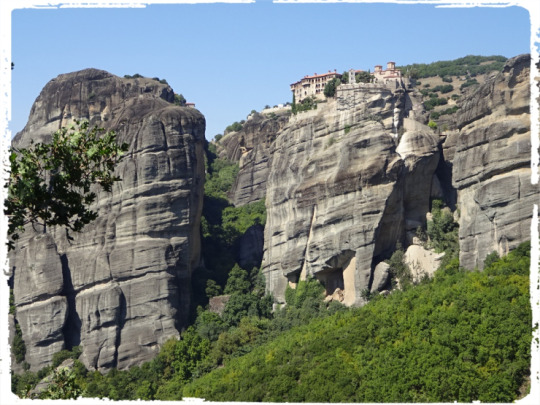

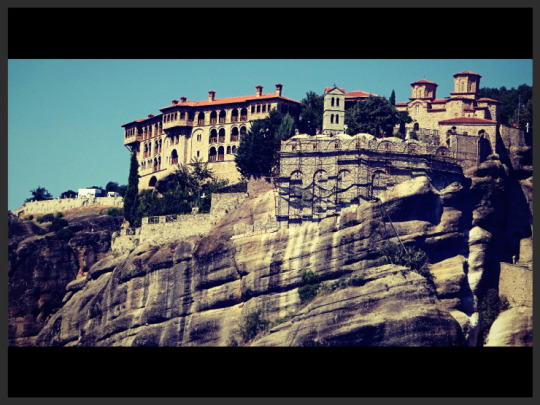
The excursion itself
The day started really early, if I remember good I was picked up from a hotel at around 6.00 a.m. and we were taken to the Port of Corfu. After that we went by ferry to Igoumenitsa, to the Greek mainland (ca 1,5 hours). From there Kalambaka is 170 km far, we first stopped at Metsovo, a traditional village to taste some cheese, wines and traditional dishes and after that we visited 2 monasteries, the Monastery of the Great Meteoron and the Monastery of Valaam.
I was surprised that the guide could hardly speak English, but it is true I didn’t ask in which language it would be. it was mostly in Russian… So the interesting information about the sights / history I looked at the different internet websites.
Hogy is néz ki egy ilyen kirándulás
A nap nagyon korán kezdődött, ha jól emlékszem az egyik szállodától 6.00 órakor vett fel a busz és Korfu kikötőjébe vitt. Ezután komppal átmentünk Igoumenitsa-ba, a görög szárazföldre (kb. 1,5 óra). Innen Kalambaka 170 km-re fekszik, először megálltunk egy hagyományos faluban, Metsovóban, ahol sajtokat, borokat és hagyományos ételeket kóstoltunk meg, majd 2 kolostort – a Nagy Meteoron kolostort és a Valaam kolostort – látogattuk meg.
Meglepődtem, hogy az idegenvezető alig tudott angolul , bár igaz, nem kérdeztem, hogy milyen nyelven lesz a kirándulás. Többnyire oroszul volt… Tehát az érdekes információknak a látnivalókról / történelemről a különböző internetes oldalakon néztem utána.
What is the Meteora?
Meteora in Greek means “suspended in the air” and it is a collection of rock pillars above the town of Kalambaka. On the top of these high rocks, the orthodox monasteries stand.
The monasteries were built between the 14th -16th centuries but much earlier, in the 11th century hermit monks lived in the caves. Only in the 1920s were steps carved into the rock, until that access to the top was via removable ladders, the food was taken there in baskets with ropes.
In the 16th century there were 24 monasteries at Meteora, they were created to serve monks and nuns of the Eastern Orthodox Church. Today 6 monasteries are functioning, the remains are in ruins. 2 of these monasteries are inhabited by nuns, the other 4 by monks.
These 6 remaining monasteries are: The Monastery of Great Meteoron (the largest of the monasteries), Varlaam Monastery (second largest), Roussanou Monastery (it is a nunnery) , Agios Nikolaos Monastery, Agios Stefanos Monastery (nunnery as well) and the Agia Triada Monastery (Holy Trinity).
They are included in the World Heritage List of Unesco. It is a pilgrimage for all Christians around the world and it is a truly breathtaking place in my opinion.
Mik is a Meteorák ?
A görög Meteora szó “levegőben lebegőt” jelent, Kalambaka város felett sziklaoszlopok csoportja. A magas sziklák tetején ortodox kolostorok állnak.
A kolostorok a 14-16. században épültek, de már sokkal korábban – a 11. században – a barlangokban szerzetesek éltek. Csak az 1920-as években faragtak a sziklákba lepcsőket , egészen addig az épületeket csak létrákon lehetett megközelíteni, az élelmiszert kosarakban kötelekkel huzták fel.
A 16. században 24 bizánci kolostor volt a Meteoráknál. Ma 6 kolostor működik, a többinek már csak a romjai találhatóak. A kolostorok közül kettőben apácák élnek, a másik 4 pedig szerzetesek által lakott.
A 6 megmaradt kolostor a következő: Nagy Meteoron kolostor (a legnagyobb kolostor), Varlaam kolostor (második legnagyobb), Rousanou kolostor (apácák élnek itt), Agios Nikolaos kolostor, Agios Stefanos kolostor (szinten apácák lakják) és Agia Triada kolostor (Szentháromság kolostor).
A Meteorák szerepelnek az UNESCO világörökségi listáján. Ez egy zarándokhely minden keresztény számára, szerintem egy lélegzetelállító hely…
Vicky
Meteora visit from Corfu / A Meteorák meglátogatása Korfuról I could finally find a company that organized excursions from the Island of Corfu to the Meteora.
#egyutazasmaniastyuknaploja#Greece / Görögország#history#Magyarul#meteora#meteorak#photography#travel#Travelblog#Travelblogger#travelguide#Travelphoto#utazas#utazasiblog#utazom#wanderlust
0 notes
Photo
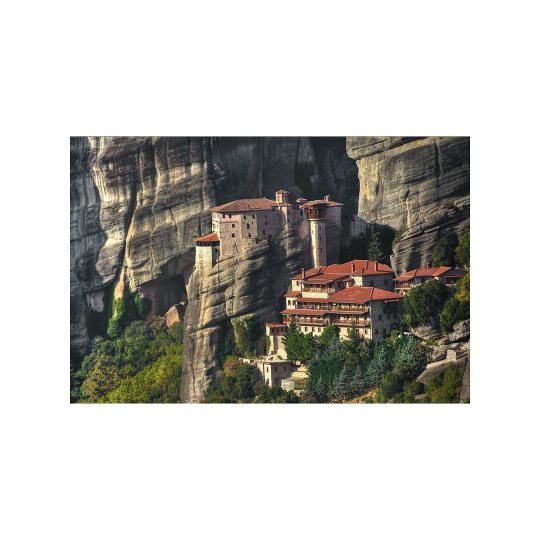
Meteora The area of Meteora was originally settled by monks who lived in caves within the rocks during the 11th Century. But as the times became more unsure during an age of Turkish occupation, brigandry and lawlessness, they climbed higher and higher up the rock face until they were living on the inaccessible peaks where they were able to build by bringing material and people up with ladders and baskets and build the first monasteries. The second largest of the Meteora monasteries the ‘Holy Monastery of Varlaam’ offers a glimpse of the difficulties the monks encountered when building their hilltop sanctuaries. It took 22 years to bring all the building materials to the summit. The ‘Varlaam Monastery’ is named for the first monk who built the first church on the rock. In 1350 Varlaan built three churches, a room for himself and a water tank. Unfortunately no other monks joined him. After his death the site was abandoned for 200 years. In 1517 two monks from Ioannina, Theophanes and Nektarios Apsarades, re-founded the monastery. Inside frescoes cover the walls of the main chapel - including a harrowing depiction of the Apocalypse. The oldest and largest of the Meteora monasteries the ‘Holy Monastery of Great Meteoron’ is the highest too, rising more than 615 meters (2,000 feet) above the valley floor. Founded by St. Athanasios, whose disciples included exiled royalty, ‘Great Meteoron’ has long been considered the most prestigious of the monasteries. Inside the sacristy skulls of the monastery’s former occupants line up neatly on shelves. (at Meteora) https://www.instagram.com/p/CW-pBCHIOeY/?utm_medium=tumblr
0 notes
Text
10 dec; flying nuns
sunday 10 dec, meteora
what we saw
visited these monasteries (in order):
holy trinity monastery (apparently the most difficult to get to- great starter)
st stephen’s monastery
roussanou monastery
great meteoron monastery (busiest)
varlaam monastery
cost per monastery - 3 euro per person
where we travelled
from here to delphi for the night
thoughts
loved going in winter - there was a mild chill - there were only a few tourist buses, and the monasteries weren’t that busy (except for great meteoron). the views are phenomenal and there is a look out point when travelling from st stephen’s to roussanou.
0 notes
Text
Mainland Greece
14 - 23 May 2017 Mainland Greece (less Athens) has been wonderful for the most part, surprising at other times, and occasionally a little distressing. The scenery, history and culture have been as wonderful as we assumed they would be, and Nafplio was an extremely pleasant surprise. However, the roads (less the magnificent toll roads) have been on a par with Vietnam (not a compliment), as has the driving, and the general malaise in the towns, especially Athens and Thessaloniki, has been upsetting. With a reasonably short time frame in which we wanted to cover off sites in north, central and southern Greece (the Peloponnese), we decided that another rental car, although considerably more expensive, was the best way to achieve our ambitious and tightly choreographed timeframe. Having spent the night in the Athenian port of Piraeus, after an extremely pleasant ferry from Santorini spent sunbathing, reading and enjoying the island views, we arrived at the Hertz office promptly after opening. A Citroen C1, with a lusty 1300cc power pack under the bonnet, was to be our quadriga of choice - "Hog 9.0". Although we found the toll roads to be slightly more expensive than anticipated (or more accurately that there were toll roads), we came to the conclusion that an average speed of 140km/hr on effectively unpolished roads was a good deal for the occasional 3 Euro. The rest of the roading system left a little to be desired though, as we were to discover on a number of "James' Specials" - more on that later. Greeks also appear to take the Vietnamese attitude towards road rules, i.e. less is more. Unfortunately, this becomes slightly more concerning when confronted with large European cars barrelling the wrong way down one-way streets, as opposed to nippy little scooters. Hog 9.0 did the job though (with some skilful navigation from Hannah, despite a flat tyre somewhere on the west coast of Greece and some diabolical blind spots, and we successfully completed our ambitious road trip - with a bonus rest day! Covering off approximately 2000km in 9 days, we were on a mission to see as much of Greece as possible. The first day was a double header, en-route from Athens to some weird little town at the base of Mt Olympus, in which we visited Delphi and Thermopylae. Delphi, primarily focused on the Sanctuary of Apollo with an adjoining museum, was an amazing start to our grand tour. Perched on the edge of a steep valley, the paths lead you up past the ruins of the votives and offerings from Greek city states celebrating great victories or just their own awesomeness, through the Temple of Apollo and the Dionysian Theatre, to the hilltop stadium overlooking them all. Having spent a couple of hours wandering the sights, Hog 9.0 took us on a slight detour to the battleground of Thermopylae. James, not willing to let the adjoining highway ruin his anticipated viewing, regaled Hannah with the history of the battle, and she was deeply impressed by his explanation of how the Spartans (and Thespians) used the ground to their advantage. Another hour of toll road speeding saw us arrive at the base of Mt Olympus, thoroughly unprepared for our ascent the next day. Mt Olympus is almost 3000m high, but is regularly hiked in summer (over two days) by people wearing boots and owning waterproof jackets. As we were hiking it in early spring, had sent our boots home (to save baggage costs on budget Euro airlines), and only possessed one genuinely water-resistant jacket (James'), we figured it would be best if we went up and down in one day. Strapping on our trusty sneakers (which are a little battered after 5 months), and with a backpack full of key hiking essentials like salami sandwiches and almonds, we set off up the trail. To be fair, in summer the summit would be totally attainable as the track is maintained and extremely easy to follow, and the views down the valleys were spectacular. To top it off, there are these wonderful European 'refuges' along the route which are actually hostels with restaurants attached. Refuge A at 2000m is just above the tree line, and the point at which we decided our hike should culminate. The weather had closed in significantly, and with visibility at 50m, heavy rain falling, snow underfoot, and lacking proper maps or a compass (Google maps and an IPhone do not count) we decided to turn around at this point (after a short break to dry out of our shoes by the roaring fire). Although we felt we could have pushed on, and the refuge manager was quite confident the path was not blocked by snow, any enjoyment was going to be short lived by 5 hours in the driving rain, in inadequate footwear and clothing. So buoyed up by an espresso each (DOC is really missing a trick here - James would have traded Hannah in for an espresso at this point) we headed back down the trail. En-route we had to make way for three donkeys and their donkey herder (probably not the official term) who had been ferrying essential stores, like espresso, up to the refuge. Defeated by the Olympian gods, with Hannah soaked through (James' jacket wouldn't have fitted), but extremely pleased with our awesome hike, we set off for Thessaoniki... ...which we speak of with a touch of disappointment... Lonely Planet owes us two days and 500km because it's description of Thessaloniki appeared to stem from when the original authors backpacked through the town sometime in the 70's. Thessaloniki could be more accurately described as the poster-child for Greece post-2008. Our AirBnB apartment was on the fringe of the city, but was ringed by graffiti covered abandoned buildings, rubbish filled streets and shuttered shops. Although the city has a fascinating history, which we discovered on a self-created walking tour of the cities monuments and museums, including the empty (actually) 2000 year old Roman forum, the rest of the city appeared to have given up, and only appeared to rouse itself for an anti-austerity/EU strike and protest, led by the Communists and Anarchists (we believe the irony was lost on them). This apathy was emphasised when we (James) decided to drive the short distance into the CBD, despite a general consensus on travel websites that this was a terrible idea, and we discovered that the people of Thessaloniki scorn parking rules like nowhere else we have been to. The following manoeuvres appeared totally legitimate: double parking in such a way that other cars parked in legitimate roadside parks are completely blocked in (we discovered this was fairly common throughout Greece); triple parking that blocks in the double parkers and reduces two lanes of traffic to less than one (but turning on your hazard lights to indicate you're coming back before your battery wears down in three days time); parking on corners inside intersections; approaching 4 way intersections as a battle for domination; and (bizarrely) slamming on the brakes in order to let any pedestrian cross randomly at all points of the street except pedestrian crossings. This brief foray into Greek urban parking was discarded when Hannah yelled something along the lines of "get me out of here!" (with a few more expletives) and then spent the drive back to our less than salubrious accommodation muttering comments about murder and justifiable homicide. With the northern section of our speed-Greece tour safely concluded, it was off to Meteora for the second part of our central Greece segment (Delphi and Thermopylae being the first). On the way, we decided to swing via Pella and Vergina, the birthplace of Alexander the Great and location of the tomb of Phillip II respectively. Pella had a lovely museum (thanks to the EU) but appeared to have done very little since Alexander the Great died. The tomb of Phillip II at Vergina was one of the more spectacular underground experiences of our travels though. Discovered in the late 19th century AD, Phllip II's tomb has been spared the ravages of tomb raiding, and although you can only view the grand entrance after descending three stories underground, it was extraordinary to be in the presence of undisturbed relics from 2300 years ago, buried to mourn the death of a man who would unite Greece under Macedonian rule, and who's son would conquer most of the known world and some of the unknown world. We have been having a few of these rather humbling experiences, but this was definitely a highlight. Meteora consists of six monasteries perched atop karst rocks, set amongst a landscape resembling Krabi or Cappadocia, and accessible by varying numbers of steps hewn into the rock face. Arriving mid afternoon, we decided to get our bearings by running up the side of one of these rocks. Our legs were a little unimpressed, a number of hiking tourists were a little bemused, but we did get some fantastic views as the sun was setting. Having only allocated a morning to viewing the monasteries, we decided to pick two as we blithely assumed they would be a little repetitive after that. This decision was made easier by two of the six being closed on the day we were visiting, one being very accessible (and therefore deemed beneath us), and a fourth being deemed "looks rubbish" by James. So we settled on The Monastery of Great Meteron and The Monastery of the Holy Trinity which were undeniably spectacular, and complemented each other well. The Monastery of Great Meteoron is the largest, the oldest, and comes replete with a mini-museum, gift shop and wonderful views back over the the town of Kalabaka and the other five monasteries. The Monastery of the Holy Trinity is much smaller, with a steep, winding staircase (thereby putting off the tour groups), and sweeping views in the opposite direction back towards the Great Meteoron. It was time to hit the road just before lunch, as we had a short 6 hour nip down to the Peloponese and Olympia ahead of us. Hog 9.0 let us down however, and our 6 hour nip turned into an 8 hour marriage test. As Hannah accelerated heavily away from a toll booth, the unmistakable 'thump, thump, thump' of a flat tyre rattled the car (there had been some earlier, brief exchanges about the state of the tires and some foreboding concerns about the fullness of one in particular). After a quick and forthright exchange of views as to where Hannah should pull over, and a second or two of frosty silence, we proceeded to change the tyre with the lighting efficiency of an F1 pit crew. The tricky question of our follow up action on a Friday afternoon in Greece quickly concerned us, as we had no cellphone, no Greek language skills, and no desire to cover another 1000km over rubbish Greek roads on a spacesaver tyre. We did however have a Hertz roadmap, with an arrow pointing at Patra (the nearest city to us and pretty much en-route) indicating the presence of a Hertz office. We decided the best thing to do was head for the nearest Hertz office, and beg for a solution (at one hopeful moment we imagined a new car coming our way) before Greece closed down for the weekend (after all it was already Friday afternoon and it appears that siestas are still very much a thing). Surmising that the Hertz arrow was pointing at the coast, and agreeing that car rental companies were likely to be near the port, we set off on our exploration, commenting that this really took us back to the 90's before wifi capable mobile phones. After three or four laps of a number of city blocks, and some blatantly incorrect directions from one gentleman, we rolled in triumphant to Hertz Patra. The Hertz Patra office manager was less chuffed to see us though, as we were quite clearly going to require him to do some work so close to the weekend. We are not convinced that the retread conducted at the garage around the corner for 20 Euros, which we were directed to after a couple of agitated phone calls, was strictly Hertz policy, as it was conducted sans paperwork and we had to ask for a receipt (which by Greek law must be provided). Still for 20 Euros and 45 minutes we weren't complaining, and we arrived in Olympia in time for a quick evening jog very near to the track on which the original Olympians used to race. Very cool. Olympia, as the name suggests, was the home of the Ancient Olympic Games, conducted every four years (regardless of rain, earthquakes or war) between representatives from various city-states and the Romans (after a while). The area, surprisingly to us, did not just consist of a big old stadium, but was actually a vast sanctuary (complex) primarily focused on the worship of Zeus. This somewhat lengthened our (planned) visiting time, particularly as James insisted on posing on the starting line inside the stadium (to Hannah's eternal embarrassment - you'd think she'd be used to this behavior by now), and Hannah insisted on going to the Museum of the History of the Ancient Olympics, which turned out to be extremely interesting and explained all the events in some detail. Hannah was unimpressed that women weren't even allowed to watch the Olympics Games, on pain of death. James pointed out that at least they held a separate women's competition. Moving on. Leaving Olympia, James decided to ignore Google maps recommended coastal route, in favour of a secondary road indicated on the Hertz map, that cut directly across the Peloponese to Nafplio, our next destination. Confidently telling Hannah that he was pretty sure Google was wrong (because that's how they make all their money) he was somewhat frustrated when the start of the road was fenced off. Deciding that perhaps it was just this section, we followed a country road until we intercepted the road again. However this section of the road, while accessible, had been de-paved (presumably to stop morons like James deciding to take it anyway - this notion was quickly disabused by Hannah), and we can only assume that Grecian austerity measures had doomed James' preferred route. However, by this point we were 35km into the centre of the Pelopennese, so we pushed on with our country roads, and through a combination of aggressive acceleration, and sheer determination, reached Napflio only 30 - 60 minutes later than Google had predicted. Hannah grew quite tired of James' obviously forced enjoyment of the scenery as we endured switchback after switchback on one lane gorge roads. Originally we had planned to spend two nights camping just outside Nafplio, with our final night before Athens in a guesthouse near Corinth. Nafplio was wonderful, and our camping supplies were limited, so we ended up camping for one night near Nafplio and then staying in a fantastic little hotel inside Nafplio. We had lugged a two-person tent through our travels in anticipation of camping opportunities in Europe, but had up to this point discovered that hotels and Air BnBs were so reasonable, and tent grounds so randomly located, that it had been uneconomical. But Triton II Camping promised beaches, power, facilities, and all within 12km of Nafplio, at half the price of a decent hotel room. However once we had factored in the cost of petrol, the inability to make our own tea and coffee, the mankiness of the beach and the general inconvenience of not being in a hotel, we retreated back to a hotel after our night. Still, at least we can say we used the tent. Nafplio was also far too lovely to be missed out on. Originally planning to use it just as a base to visit Mycenae and the Theatre of Epidaurus, we decided to squeeze in a "weekend day" just to enjoy the town. The Old Town was the most beautiful we have been to in Greece (except maybe Santorini), the walks (or runs in our case) around the coastline and up to the hilltop castle(s) were spectacular, our hotel 'Pension Asimoni' was one of favourites in the semi-budget category, and there was a great gym called 'Lions Power' run by the friendly Mario. To make it better, we got to the Theater of Epidaurus first one morning, and got to enjoy it in silence (except for us testing the acoustics) before the perennial tour groups turned up, and we had a very interesting couple of hours exploring the ruins of Ancient Mycenae. We were extremely sad to leave Nafplio, but Athens was calling, with a little detour via Corinth en-route.
0 notes
Photo
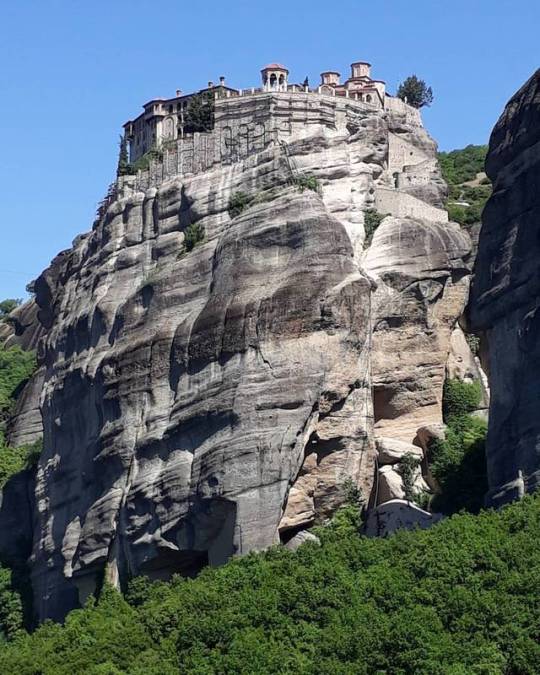
The All Seeing Holy Monastary.. Grand Meteoron.. Taken at #meteora. ❤❤❤😉 #grandmeteora #visitmeteora #visitgreecegr #travel #summer #photooftheday #canonuk #instagram #instalove #instagr #photo #instalike #instatag #onassignment #photooftheday #manfrotto #calumet #greece #thessaly #revealgreece (at The Monastery of Great Meteoro)
#meteora#photo#onassignment#travel#canonuk#summer#instagram#thessaly#photooftheday#instalike#visitmeteora#manfrotto#instalove#greece#calumet#revealgreece#instagr#visitgreecegr#instatag#grandmeteora
0 notes
Photo
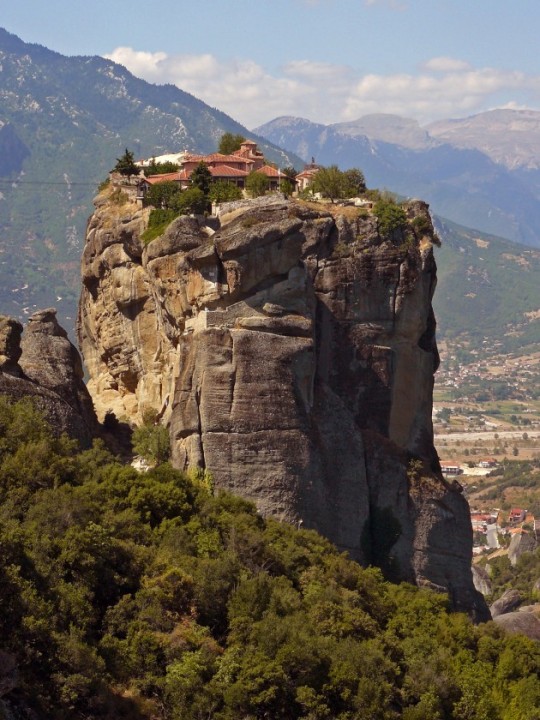
Meteora, Greece
Meteora is the biggest and most important group of monasteries in Greece after those in Mount Athos. We can locate the first traces of their history from 11th c. when the first hermits settled there. The rock monasteries have been characterized by UNESCO as a unique phenomenon of cultural heritage and they form one of the most important stations of cultural map of Greece.
The most important monasteries of Meteora are:
- The Holy Monastery of Great Meteoron.
- The Holy Monastery of Varlaam.
- The Holy Monastery of Rousanou.
- The Holy Monastery of St. Nicholas Anapausas.
- The Holy Monastery of St. Stephen.
- The Monastery of Holy Trinity.
Source: http://www.visitgreece.gr/en/religion/monasteries/meteora
0 notes
